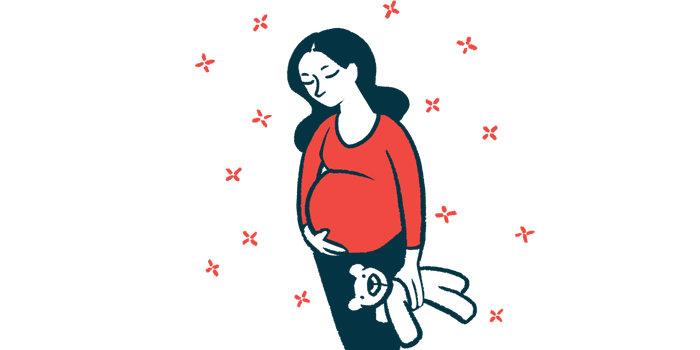Woman With CF and Complications, Using Trikafta, Has Healthy Child
Pregnancy with history of flares, P. aeruginosa infection, pancreatic insufficiency
Written by |

A 30-year-old woman with cystic fibrosis (CF) and poor lung function gave birth to a healthy child while being treated with Trikafta, reportedly the first such successful CF pregnancy in Switzerland.
The mother’s percent predicted forced expiratory volume in one second (ppFEV1) — meaning her expected ability to quickly empty her lungs after a deep breath — was lower than 50%, its scientists noted, a value associated with a “risk for preterm delivery and … infants with lower birth weight for the gestational age.”
The report, “Successful pregnancy in a cystic fibrosis patient with a severe impairment of lung function receiving Elexacaftor-Tezacaftor-Ivacaftor,” was published in the journal Respiratory Medicine Case Reports.
Unplanned pregnancy in CF patient four months after starting Trikafta
Mutations in the CFTR gene, which codes for a protein of the same name, causes CF. Problems with this protein are associated with reduced fertility. In women, they result in thicker cervical mucus and a pH imbalance that impacts sperm mobility and fertilization.
Moderate-to-severe lung function impairment in women with CF, defined as a ppFEV1 less than 50%, also associate with a higher risk for preterm and cesarean delivery, and newborns at risk because of their low birth weight.
Trikafta (elexacaftor, tezacaftor, and ivacaftor), a highly effective combination CFTR modulator, is known to improve patients’ lung function and nutritional status, and is linked with fewer pulmonary exacerbations — a sudden worsening of lung symptoms — and a better quality of life. CFTR modulators are also known to aid fertility, with unplanned pregnancies reported in women on these therapies.
A team headed by researchers at Lausanne University Hospital helped to treat a pregnant 30-year-old with an F508del mutation in one CFTR gene copy and a Y1092X mutation in the other. The woman had bronchiectasis, characterized by long-term widening of the lungs’ airways and excessive mucus buildup, that was associated with Pseudomonas aeruginosa infection, and she had pancreatic insufficiency.
After an infectious exacerbation in 2017, her pulmonary function fell sharply — a ppFEV1 of 23% — and she had severe malnutrition. She also showed signs of pulmonary hypertension and a patent foramen ovale, or small hole between the upper heart chambers that exists in a fetus but usually closes after birth. She refused a lung transplant being considered by her medical team.
In the following years, the woman’s ppFEV1 remained stable at 30%, but her overall health status was poor, particularly during infectious exacerbations. Her ppFEV1 fell to its lowest value, 21%, in February 2019.
She started treatment with Trikafta in August 2020 through a compassionate access program before its February 2021 approval in Switzerland, the researchers noted. Her overall health improved, her respiratory symptoms eased, and her ppFEV1 rose to 40% one month later. She also showed better nutritional status and had no further exacerbations requiring treatment with antibiotics.
An unplanned pregnancy, this patient’s first, occured four months after treatment initiation. After a genetic evaluation of the couple and a discussion of risks for the mother and child, the woman decided to continue the pregnancy.
“Despite the current scarcity of reproductive safety data, we pursued ETI [Trikafta] considering the risk for maternal deterioration upon treatment cessation,” the investigators wrote.
Normal fetal development was seen over the course of the pregnancy, and the mother’s ppFEV1 values held stable at 35% to 40%, similar to pre-pregnancy values, over 31 weeks of gestation (around seven months).
Vaginal delivery of baby at 36 weeks of gestation
Around that time, however, she began having symptoms of preterm labor. The woman was hospitalized and given medications to aid fetal lung development. Low oxygen levels during sleep (nocturnal hypoxemia) prompted the use of supplemental oxygen, and she contracted a rhinovirus infection that was treated with respiratory physiotherapy and medicine. She was discharged after about one week, but returned at 33 weeks of gestation due to excessive amniotic fluid. Doctors removed 2,700 mL of the fluid.
Her baby was born healthy at 36 weeks — considered the start of the ninth month — of pregnancy by vaginal delivery, weighing 2.7 kg (about 6 lbs). The child was developing normally over a first year of life, the scientists reported.
The woman’s nocturnal hypoxemia corrected rapidly after giving birth and she stopped oxygen therapy. An ppFEV1 of 40% was again recorded four months after childbirth, and her functional status also returned to pre-pregnancy levels.
“Our case highlights the new challenges and opportunities clinicians and individuals with CF may face in the era of highly effective CFTR modulators regarding fertility and pregnancy,” the scientists wrote.
Considering that most women starting or using this CF therapy are of childbearing age, family planning and contraception discussions should be considered to prevent unplanned pregnancies and for “informed decision making” in a planned pregnancy, they added.
“Improvements in quality of life, pulmonary function and the lower risk of exacerbations during treatment with highly effective CFTR modulators” may also “allow childbearing to be (re)considered by more CF women with decreased pulmonary function,” the researchers concluded.







